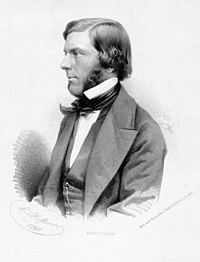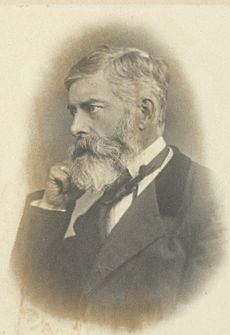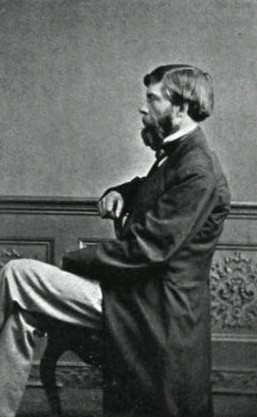Alexander William Williamson facts for kids
Quick facts for kids
Alexander William Williamson
|
|
|---|---|

Alexander William Williamson
|
|
| Born | 1 May 1824 Wandsworth, London, England
|
| Died | May 6, 1904 (aged 80) Hindhead, Surrey, England
|
| Resting place | Brookwood Cemetery |
| Nationality | British |
| Alma mater | University of Giessen |
| Known for | Synthesis of ethers |
| Awards | Royal Medal (1862) |
| Scientific career | |
| Doctoral advisor | Leopold Gmelin Justus von Liebig |
Prof Alexander William Williamson (1 May 1824 – 6 May 1904) was an important English chemist. He is most famous today for creating a special way to make chemical compounds called Williamson ether synthesis. This method helps scientists create new substances.
Contents
Life of Alexander Williamson
Alexander Williamson was born in 1824 in London, England. He was the second of three children. His father worked for a big trading company.
Even though he had some health challenges early in life, like losing sight in one eye, he grew up in a very supportive home. His family encouraged him to learn and think.
He went to schools in Kensington. In 1841, he started studying at the University of Heidelberg. Later, he moved to the University of Giessen. There, he worked with famous chemists like Justus von Liebig. He earned his PhD in 1845. After that, he spent three years in Paris, studying advanced math.
In 1849, Alexander Williamson became a chemistry professor. He taught at University College, London. He taught about how to analyze chemicals and how to do practical chemistry. In 1855, he also became the head of general chemistry. He kept this job until he retired in 1887.
With his new job, he earned more money. In 1855, he married Emma Catherine Key. They had two children, Oliver and Alice. Alexander Williamson passed away on May 6, 1904, in Surrey, England. He was buried in Brookwood Cemetery.
His Chemistry Research
Williamson is well-known for his work on making a type of chemical called ethers. He found a way to create unsymmetrical ethers. This happens when two different chemical groups join together. This process is now called the Williamson ether synthesis.
He thought that ethers and alcohols were similar to water. He believed they were built in a similar way. He also suggested that the "water-type" idea could help classify many chemical compounds. This meant comparing how different chemicals were structured to how water is structured.
In 1850, he also had an interesting idea about how chemicals work. He thought that in a group of molecules, the parts are always swapping places. For example, in hydrochloric acid, the hydrogen and chlorine atoms don't just stay together. They constantly exchange partners with other hydrogen and chlorine atoms. This idea was very important for understanding how ions behave in solutions.
Williamson and the Chōshū Five
In 1863, five students from Japan secretly left their country. At that time, Japan was a "closed society." This meant it was against the law to travel outside Japan. Breaking this law could even lead to death.
After a long journey, these students arrived in London. Professor Williamson and his wife, Catherine, took care of them. They welcomed the students into their home. They taught them English and helped them learn about Western society. They also arranged for them to study at University College London.
Three of the students, Itō Shunsuke, Endō Kinsuke, and Nomura Yakichi, lived with the Williamsons. The other two, Inoue Monta and Yamao Yōzō, lived near the university.
These five students later became known as the "Chōshū Five." They all went on to serve in the Japanese government. They made big contributions to modernizing Japan. Later, in 1865, fourteen more Japanese students also came to study with Professor Williamson.
Awards and Recognition
For his important work on ethers, Alexander Williamson received a special award. He got a Royal Medal from the Royal Society in 1862. He had become a member of the Royal Society in 1855. He also served as their foreign secretary for many years.
He was also the president of the London Chemical Society twice. First, from 1863 to 1865, and again from 1869 to 1871.
See also
 In Spanish: Alexander William Williamson para niños
In Spanish: Alexander William Williamson para niños





